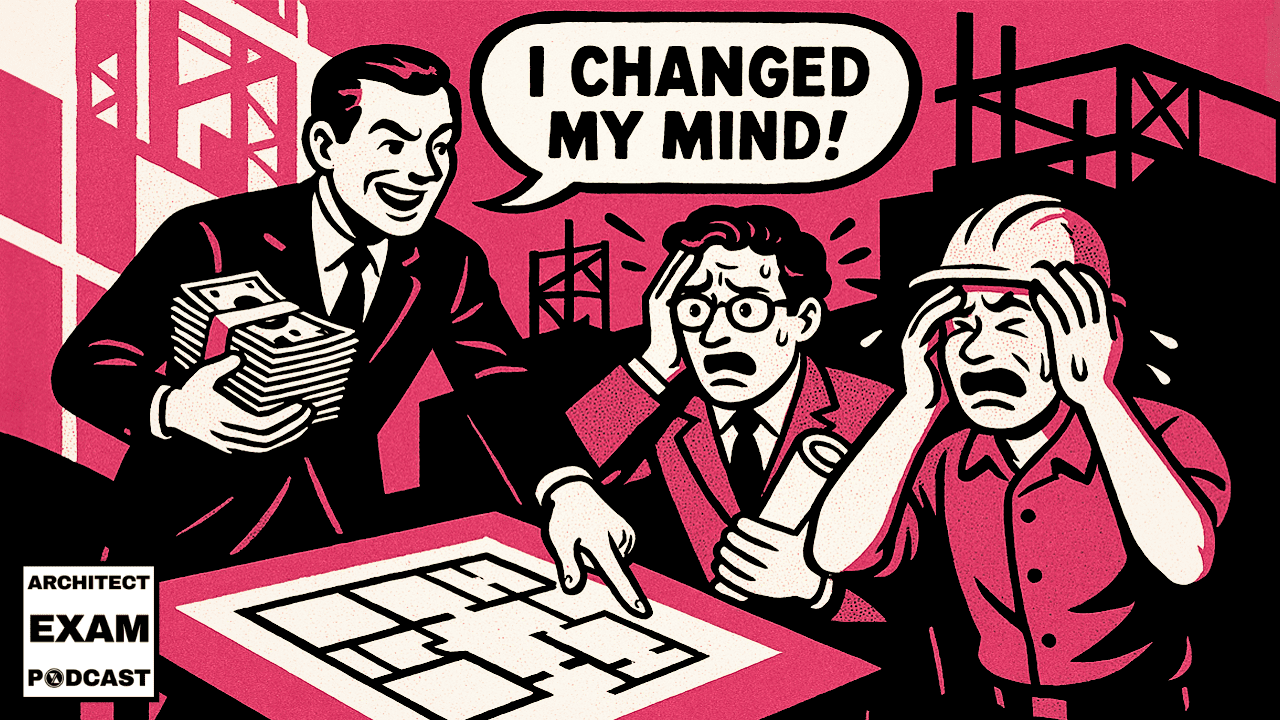Understanding what is a change order in construction is crucial for project success. Construction change orders are formal contract amendments that require three-party agreement and always increase costs compared to original work. This guide explains the process, contract modifications like construction change directives and addenda, and proven management strategies for architects and contractors navigating these inevitable project changes.
This podcast is also available on YouTube, Spotify, and Apple Podcasts
The Inevitability of Change
If there’s one constant in construction, it’s chaos – and that’s where effective modification management becomes your secret weapon.
After 20+ years in this industry, I’ve seen even the most meticulously planned projects thrown into disarray by a single unexpected field condition. That’s why understanding what change orders are and how to handle them properly is absolutely crucial.
I’ve lived and breathed the documentation professionals deal with from virtually every perspective: approving handwritten modifications on residential projects, processing millions in changes as an owner’s rep on government projects, and now teaching bewildered exam candidates how to master these concepts.
Changes in construction will make or break your career – they’re unavoidable.
While real-world procedures vary widely across the industry, today we’re focusing on how formal construction change orders work according to AIA standards – which is exactly the way they’ll appear on your Architect Exams.
By the end of this post, you’ll understand:
- What is a change order and when they’re used
- The complete process from identification to implementation
- How change orders compare to other contract modifications
- Common errors and how to avoid them
- Strategies for exam success
What Is a Construction Change Order?
According to the American Institute of Architects, a change order is:
“a written instrument prepared by the Architect and signed by the Owner, Contractor, and Architect stating their agreement upon: 1) the change in the Work; 2) the amount of the adjustment in the Contract Sum; and 3) the extent of the adjustment in the Contract Time.”
In plain English: A modification is a formal amendment to the original construction contract that changes the contract’s dollar amount and/or schedule.
Key point: These modifications can ONLY happen after the construction contract has been signed and executed. This distinguishes them from other types of modifications we’ll discuss later.
Definition and Characteristics
Construction change orders have several defining features:
- They require three-party agreement between owner, contractor, and architect
- They only occur after the construction contract is signed
- They modify scope, cost, time, or a combination of these elements
- They use standardized forms like the AIA document (G701)
Types of Change Orders in Construction
Additive Modifications increase the scope of work and typically the contract sum. For a change order example, when an owner decides during construction to upgrade to premium finishes, this would generate an additive modification increasing both materials and labor costs.
Deductive Modifications decrease the scope and typically reduce the contract sum. For instance, when an owner eliminates custom millwork to save costs midway through a project, this deductive change order removes work from the original contract scope.
The Golden Rule of Construction Changes
Here’s the most important truth about construction change orders: It will ALWAYS be more expensive to add or change something via modification than if it was included in the original contract.
Think of it like booking a flight – changing your ticket last minute costs significantly more than getting it right the first time.
Once the construction contract is signed, prices are locked in, teams are scheduled, and materials are ordered. Any disruption to that plan inevitably costs more.
This is why maintaining adequate construction contingency is critical – changes are inevitable, and they always cost more after the contract is signed.
The Process in Construction
Let’s walk through the complete process from start to finish:
Step 1: Identification of Need for Change
The process begins when someone identifies a need for change. This could be:
- The owner wanting something different
- The contractor discovering an issue in the field during routine construction observation activities
- The architect identifying a necessary design modification
Most construction contracts require notification within 5-10 days of discovery. Contractors can lose thousands by sitting on these issues too long and forfeiting their right to additional compensation.
Step 2: Request Documentation
The contractor prepares a formal Request (COR) that documents the proposed change, its justification, and impacts.
A properly prepared request must include:
- Crystal-clear description of what’s changing and why
- Specific references to affected drawings or specifications
- Supporting evidence like photos or field reports
- Detailed cost breakdown and schedule impacts
Step 3: Architect Review and Evaluation
The architect reviews the request, considering three key questions:
- Is this change legitimate and outside the original scope?
- Are the proposed costs reasonable?
- Is the schedule impact justified?
For technical issues, the architect often coordinates with consultants to verify proposed solutions.
Step 4: Negotiation Between Parties
This is where real discussion happens about scope, cost, and schedule adjustments. There’s typically back-and-forth between parties to refine the proposal.
Common negotiation points include labor rates, material markups, overhead and profit percentages, and time extensions. Every contractor proposal starts with proper documentation and clear justification for the requested changes.
Step 5: Formal Documentation Using AIA Forms
Once details are worked out, the architect prepares the official change order, typically using the AIA form (G701).
Key exam point: The architect creates the change order with data provided by the contractor – not the other way around.
Step 6: Approval and Signatures
The change order becomes official once all three parties sign it. Typically, the architect signs first, then the contractor, and the owner signs last.
Once signed, the change order has the same legal status as the original contract – it’s a binding modification.
Step 7: Implementation and Log Tracking
The contractor implements the changed work while the project team maintains a detailed change order log – one of the most underrated tools in effective modification management.
A well-designed tracking log works similarly to a construction submittal log – both track critical project information that flows between parties. While a submittal log tracks shop drawings and product data approvals, a tracking log records:
- Each order’s number and date
- Description and cost impact
- Schedule impact and approval status
Maintaining an accurate tracking system is essential for project success because it provides a clear audit trail of all modifications and their cumulative impact on the project.
Step 8: Schedule of Values Update
Once approved, the contractor adds line items to the Schedule of Values.
The original Schedule of Values remains unchanged – new line items are added specifically for modified work.
Change Orders vs. Other Contract Modifications
Change orders are just one type of contract modification. Here’s how they compare:
| Modification Type | When Used | Who Signs | Cost/Time Impact |
|---|---|---|---|
| Change Orders | When all parties agree | Owner, Contractor, Architect | Can affect both |
| Construction Change Directives | Work must proceed immediately | Owner and Architect only | Determined later |
| Architect’s Supplemental Instructions | Minor changes only | Architect only | None |
| Addenda | Before contract signing | Architect (with owner approval) | Reflected in bids |
Construction Change Directive vs Change Order
CCDs are directives issued when work must proceed immediately but parties haven’t agreed on terms.
Every CCD eventually becomes a change order once cost and time details are worked out.
Think of a CCD like finding a water leak during renovation. You tell your contractor, “Start fixing this leak right now – we’ll figure out the exact cost later.”
Architect’s Supplemental Instructions (ASI)
ASIs are architect-issued instructions for minor changes that don’t affect cost or time.
They cannot change cost or time and only require the architect’s signature.
Addendum vs Change Order
Addenda are modifications made to bidding documents before the contract is signed during the bidding process.
They’re the only modification type that happens pre-contract.
Choosing the Right Contract Modification
Use this simple decision process:
- Has the construction contract been signed yet?
- If NO: Use Addendum
- If YES: Continue to question 2
- Does the change affect cost or schedule?
- If NO: Use Architect’s Supplemental Instruction (ASI)
- If YES: Continue to question 3
- Do all parties agree on the change, cost, and schedule impacts?
- If YES: Use Change Order
- If NO: Use Construction Change Directive (CCD)
Understanding Clauses in Construction Contracts
Most construction contracts include specific change order clause in construction contract language that defines:
- Time limits for notification of potential changes
- Required documentation for requests
- Approval procedures and signature requirements
- Markup percentages allowed for overhead and profit
- Dispute resolution procedures for contested changes
Understanding these contractual provisions is crucial for proper management and helps prevent disputes before they arise.
Management Best Practices
After years in the trenches of construction change management, here are proven strategies:
Prevention Strategies
- Thorough preconstruction phase planning – invest time in comprehensive site investigation
- Clear process protocols – establish systems everyone understands from day one
- Detailed contract documents that avoid common specification writing errors – reduce ambiguity that leads to disputes
Documentation Best Practices
- Standardized form usage – consistently use industry-standard forms like AIA G701
- Robust log maintenance – implement detailed tracking systems
- Weekly process reviews – make status a standing agenda item
Quality Integration
- Incorporate review into your overall quality control process
- Ensure changes don’t compromise design intent or code compliance, particularly for critical life safety systems like means of egress requirements
Common Errors to Avoid
Timing and Documentation Mistakes
- Not getting timely notifications – most contracts require notification within days
- Verbal approvals without documentation – always follow up with written confirmation
- Incomplete information – missing details delay approval
Financial and Process Errors
- Not tracking cumulative impacts – individual changes seem minor but add up quickly
- Ignoring contract requirements – pay attention to markup percentages and timeframes
- Not considering liability implications – poor documentation increases professional liability exposure and can compromise your standard of care
Understanding Change Orders for Professional Development
Construction change order management is critical for professional practice and exam success. Mastering AIA contract documents and their procedures is essential for both practice and ARE preparation. You need to understand:
- The roles of different parties in preparing and signing documents
- When each modification type is appropriate to use
- Which forms are used for different scenarios
- The proper sequence of the process
Construction Change Order Concepts for ARE and CDT Success
Master these fundamentals:
- Three-party agreement requirements for modifications
- When they can be used (only post-contract)
- Document preparation responsibilities (architect creates the form)
- Signature requirements for each modification type
Understanding the complimentary relationship between drawings and specifications is critical for properly evaluating requests.
Common Misconceptions
Timing confusion: Remember that changes in construction can ONLY happen after the contract is signed. Before contract signing? That’s an addendum vs change order situation.
Signature requirements: Understand who needs to sign each document:
- Change Order = Owner, Contractor, Architect (all three must sign)
- Construction Change Directive = Owner, Architect (no contractor signature)
- ASI = Architect only (simplest approval process)
ASI limitations: ASIs cannot be used for anything that affects cost or time – this is a common misunderstanding.
Mastering the Process
Now you understand what is a change order in construction: a formal contract amendment requiring three-party agreement that adjusts both contract time and money when scope changes.
Remember the golden rule: changes after contract signing ALWAYS cost more and take longer than if they were in the original scope.
Effective management hinges on:
- Prompt documentation
- Clear communication
- Systematic tracking
In my decades of experience, change isn’t just inevitable in construction—it’s guaranteed. The successful professionals aren’t those who avoid changes (impossible!), but those who develop robust systems to manage the process effectively.
Master this process, and you’ll distinguish yourself in this industry immediately.
Ready to take your construction change order knowledge from confused to confident?
Looking to master construction documentation concepts for the ARE? Check out our comprehensive Construction & Evaluation 101 (CE 101) course where we break down every aspect of the form, process, and management with real-world examples.
Want to learn more about Construction Administration? Our CDT 101 course covers everything you need to know about procedures and how to handle even the most complex situations.
For comprehensive ARE preparation covering all aspects of management, explore our ARE 101 courses with detailed coverage of contract modifications and construction administration.



